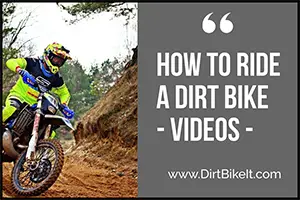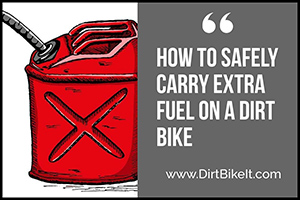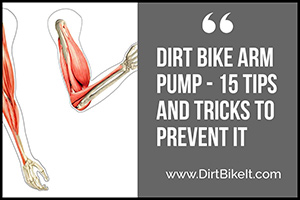How to Do a Wheelie on a Dirt Bike Beginner’s Guide
Have you ever seen a dirt bike rider performing a wheelie, riding on one wheel? Have you ever wondered how cool it would be to be able to do the same thing? Have you ever thought that a wheelie must be oh so difficult to perform?
Well, we’re here to tell you that it’s not. Performing a wheelie is not that difficult at all. It’s just a question of balance and technique. Anyone can quickly learn how to do it. Here’s how.
The Basic Idea
You can perform a wheelie both while sitting down and standing up as your bike moves. Standing up gives you more control, but if you’re a beginner, you want to start off doing it sitting down. What you need to do is sit towards the rear of your bike, distributing your weight towards the back wheel. Next, shift to a gear that allows you to freely roll the throttle. Then roll the throttle extremely quickly, sending your front wheel soaring upwards. Simply roll the throttle some more to pull the front wheel to a greater height, maintaining the wheelie. Tap the rear brake lightly if you want to pull the wheel back down. And voila, you have performed a wheelie.
Some Tips on Performing Wheelies
It takes time and effort to master performing wheelies. You don’t want your bike flipping and causing you injuries.
You can perform two kinds of wheelies, the first starting from when your bike is in a stationary position and you are standing up, which is good for beginners, and the second from when your bike is already in motion, you either sitting or standing on it, called a power wheelie, which is good for maintaining wheelies over longer distances.
Your lower body is the most important part to get right if you want to do a wheelie. You want to firmly grip the bike using your legs, sitting back on it. But be careful not to sit back too far. Nor should you sit too far forward. Sitting too far back or too far forward both put you at risk of looping out, which means falling, sending you crashing to the ground, back first. To ensure that you are sitting on the right spot, sit so that your butt hits your seat pad’s back. There is another way to measure that you’re sitting in the ideal spot: you should be able to place three fists between where you’re sitting and the tank. Keep your upper body in a neutral position, your elbows at forty-five-degree angles, ninety-degree angles at the shoulders, hips and knees. Keep one or two fingers on the clutch, one finger on the front brake, and place one of your feet over the pedal of the rear brake. If ever you feel like you’re about to flip your bike backwards, looping out, lightly tap the rear brake, bringing the front wheel back down.
Choose your gear. Our suggestion to beginners is to begin from a stationary position, going right into your wheelie. You will obviously need to be in the first gear for this. Roll the throttle, using only one-fourth of it while in first gear, revving up the engine, pulling the clutch and front brake in, keeping your bike stationary, then release your clutch and front break simultaneously and swiftly, in one sudden motion, popping the front wheel up. You can gently pull the handlebars back at the same time if you feel the need to. You shouldn’t have any trouble as long as your body position is correct, neutral, and stable; you are balanced and roll the throttle to the right extent. You will naturally develop a sense of how to balance these factors as you practice your wheelies.
And speaking of practice, that’s what being able to perform wheelies is all about. Find a nice, wide expanse of land, such as perhaps a beach, and start practicing. You may find in the beginning that you able to pull your wheel up for a very short period of time, such as up to a second. But with practice, you will learn how to maintain it for longer. Once you have practiced a fair amount, you will find that you can shift through the gears while holding the wheelies for whatever time period you desire, putting you in complete control. During your practice, you will find your bike’s sweet spot, a point in the balance where your bike feels like it’s weightless. That’s the point you want to stay in, using your throttle and rear brake to stay there, the throttle taking your front wheel higher, the rear break lowering it. Most people whose bikes loop out don’t use their rear brakes correctly. So, always keep one of your feet over the pedal of the rear brake, preventing looping out. The feeling once you find the sweet spot of balance is indescribable; the feeling is amazing.
How to Perform Wheelies Without Crashing
The first thing you may want to try while you’re beginning to learn how to perform wheelies is to hang your feet from off your dirt bike’s back, dragging them along the ground, not keeping them on the available pegs, shifting your weight back further, allowing you to break a potential fall to either side with either foot. In case the need to use the foot brake arises, you can easily lift one of your feet to the pegs made for them.
You may also want to start your lessons on how to perform wheelies on smaller pit bikes, or bikes of lower CC. These bikes, being much lighter, are easier to pop up. They are additionally much easier to manage in case they start to tip.
You want to find a surface that’s flat when you’re beginning to learn how to perform a wheelie. Bumps and bruises on the surface you use can make it much easier to loop out or to fall on either side. While performing a wheelie you have to balance both back to front and side to side, meaning there are a lot of balls to juggle. A smooth surface will help both balances.
Maintaining the right balance, as we’ve said, is a question of using the throttle and rear brake correctly. If you feel your balance veering too far forward, roll the throttle, bringing the front wheel up; if you feel it veering too far back, lightly tap the rear brake, bringing the front wheel down.
How to Improve Your Wheelie
Here are a few tips for once you have a basic idea of how to perform a wheelie and can do it fairly easily. These tips are for improved balance and, of course, looking cooler, which, let’s face it, is what it’s all really about.
While seated on your dirt bike, still in first gear, roll the throttle a few times, really revving up the engine. Let go of the clutch, popping the front wheel up. Then, using the rear brake, accelerator and clutch, try to keep the front wheel up for the maximum amount of time you possibly can, moving slowly forward. This looks amazingly cool when you pull it off correctly. But be warned, it’s a lot harder than it appears at first sight. It takes a lot of skill and balance.
While you’re in a wheelie, the front tire up, bike going forward, try to turn your front tire from one side to the other with the handlebars. This also looks amazingly cool. But again, it requires a great deal of effort, both physical and mental, physical effort to maintain the correct throttle, and mental effort to keep going straight despite the handlebar turns.
It is, as we’ve said, recommended that beginners start learning how to perform a wheelie from a stationary position, in the first gear. But once you have learned how to do this, you can experiment performing a wheelie while the bike is in motion, moving into your wheelie while in the second or third gears. Some riders even find it easier to perform a wheelie with their bikes moving fast, the momentum of the bike giving them a steadying influence, their wheelies easier to maintain over longer distances and longer stretches of time.
Once you’re comfortable performing a wheelie while dragging your feet along the ground, you may want to try performing a wheelie standing up with your feet on the foot pegs. The latter looks much cooler than the former and requires more skill too.
Once you have mastered the basic wheelie, you can take greater risks, standing with your feet on your seat, reaching down to get to the handlebars. This is a bit riskier. You should really know what you’re doing before attempting it.
Exercise Caution
Wheelies may be easy to learn, but they are advanced tricks on dirt bikes nonetheless. Therefore, it should go without saying that you shouldn’t attempt wheelies till you’ve mastered the basic skills of driving a dirt bike. Always perform wheelies wearing all of your protective gear and always exercise caution. The protective gear includes a helmet (in case an unexpected accident happens), goggles (for good visibility, particularly in a bad light), body armor (for protecting your elbows, shoulders, back and the front of your body), and gloves. For your lower body, you want gear especially made for dirt bikes, gear which is flexible, adjustable and stretchy, and has padding to protect your legs from the heat of the bike. You do not want to ride a dirt bike in your jeans. They simply won’t allow you to move as freely as you will need to. You will also want something to protect your knees with. Here, you ought to make a large investment, putting your safety first, and buy knee braces that will stop your knee from bending and twisting in ways that it shouldn’t. At the very least buy a knee guard. For your feet get good quality high boots that will support your feet and ankles. The helmet, knee protection and boots are most important parts of your gear, helping keep you safe, so go ahead and spend some money on them.



